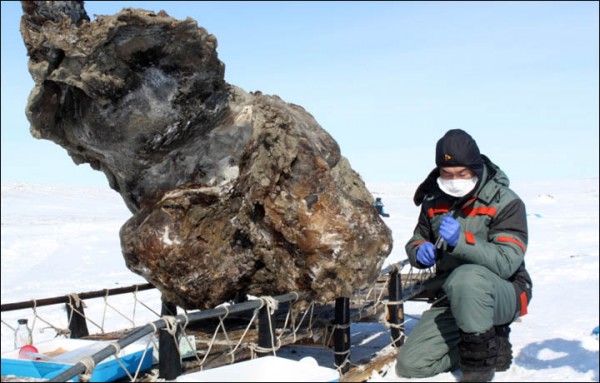Woolly Mammoth DNA Combined with Elephants to Combat Climate Change
| Ana Verayo | | Mar 26, 2015 09:44 AM EDT |
(Photo : Semyon Grigoriev) A portion of the female woolly mammoth found in Siberia with liquid blood is still present in the animal.
For the first time ever, woolly mammoth DNA has been integrated with the genetic code of modern elephants to bring the extinct elephant from extinction and even combat climate change.
Researchers from Harvard University spliced the genetic code from the extinct prehistoric woolly mammoth into 14 different sections of DNA that belonged to modern elephants. The mutated DNA codes will now develop mammoth features on modern elephants such as thick fur, extra body fat, smaller ears and a strong tolerance for colder conditions.
Like Us on Facebook
Mammoths became extinct some 3,000 years ago but well preserved DNA was obtained from their frozen carcasses in ice.
The closest relative of the woolly mammoth is the Asian elephant, which is now in danger of extinction due to increasing pressure from human interaction. This study was carried out in an effort to protect the species by allowing them to flourish in colder climates, far away from human populations.
According to George Church, a professor of genetics from Harvard University, elephants are currently in danger since they also overlap human habitats. If the elephants can be relocated and readapted where there is low human density, their chances of survival will definitely be higher.
Due to the Harvard Woolly Mammoth Revival study, scientists hope to develop new kinds of Asian elephants to repopulate the frozen tundras in Asia and even North America.
Researchers believe that the reintroduction of these large mammals into the tundra can even help offset the effects of climate change. Mammoths once roamed Asian grasslands along with other animals such as deer, antelope and horses.
They disappeared during the end of the Pleistocene epoch. When the animals disappeared, the grasslands transformed into tundras.
Researchers said that without grasslands to protect and insulate them, the tundra's permafrost is now melting, releasing greenhouse gases into the atmosphere that were trapped for more than 100,000 years. When permafrost melts, it's like burning all the world's forests two and a half times, said scientists.
If grasslands were to protect this permafrost from melting, their presence can not only slow the melting of permafrost but also isolate carbon emissions from vehicles and factories. This is also a very good sign for biodiversity to increase in these regions since new elephants will roam, new plants and animals can also take advantage of this new habitat.
TagsWoolly Mammoth DNA Combined with Elephants to Combat Climate Change, woolly mammoths, elephants, DNA woolly mammoths elephants
©2015 Chinatopix All rights reserved. Do not reproduce without permission
EDITOR'S PICKS
-

Did the Trump administration just announce plans for a trade war with ‘hostile’ China and Russia?
-

US Senate passes Taiwan travel bill slammed by China
-

As Yan Sihong’s family grieves, here are other Chinese students who went missing abroad. Some have never been found
-

Beijing blasts Western critics who ‘smear China’ with the term sharp power
-

China Envoy Seeks to Defuse Tensions With U.S. as a Trade War Brews
-

Singapore's Deputy PM Provides Bitcoin Vote of Confidence Amid China's Blanket Bans
-

China warns investors over risks in overseas virtual currency trading
-

Chinese government most trustworthy: survey
-

Kashima Antlers On Course For Back-To-Back Titles
MOST POPULAR
LATEST NEWS
Zhou Yongkang: China's Former Security Chief Sentenced to Life in Prison

China's former Chief of the Ministry of Public Security, Zhou Yongkang, has been given a life sentence after he was found guilty of abusing his office, bribery and deliberately ... Full Article
TRENDING STORY

China Pork Prices Expected to Stabilize As The Supplies Recover

Elephone P9000 Smartphone is now on Sale on Amazon India

There's a Big Chance Cliffhangers Won't Still Be Resolved When Grey's Anatomy Season 13 Returns

Supreme Court Ruled on Samsung vs Apple Dispute for Patent Infringement

Microsoft Surface Pro 5 Rumors and Release Date: What is the Latest?










